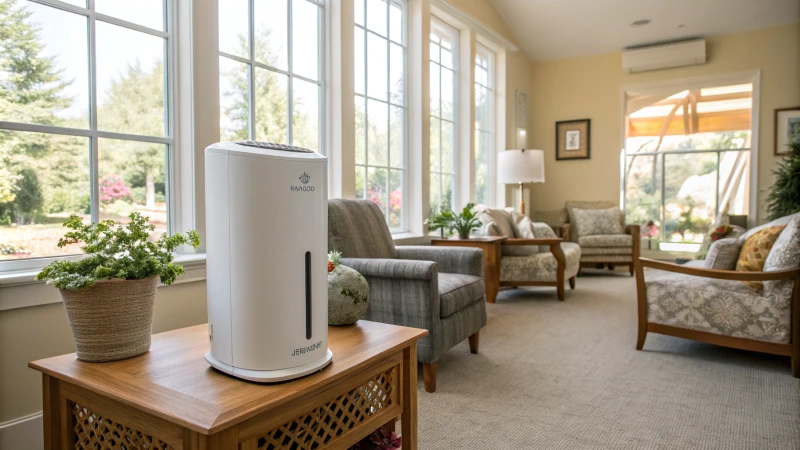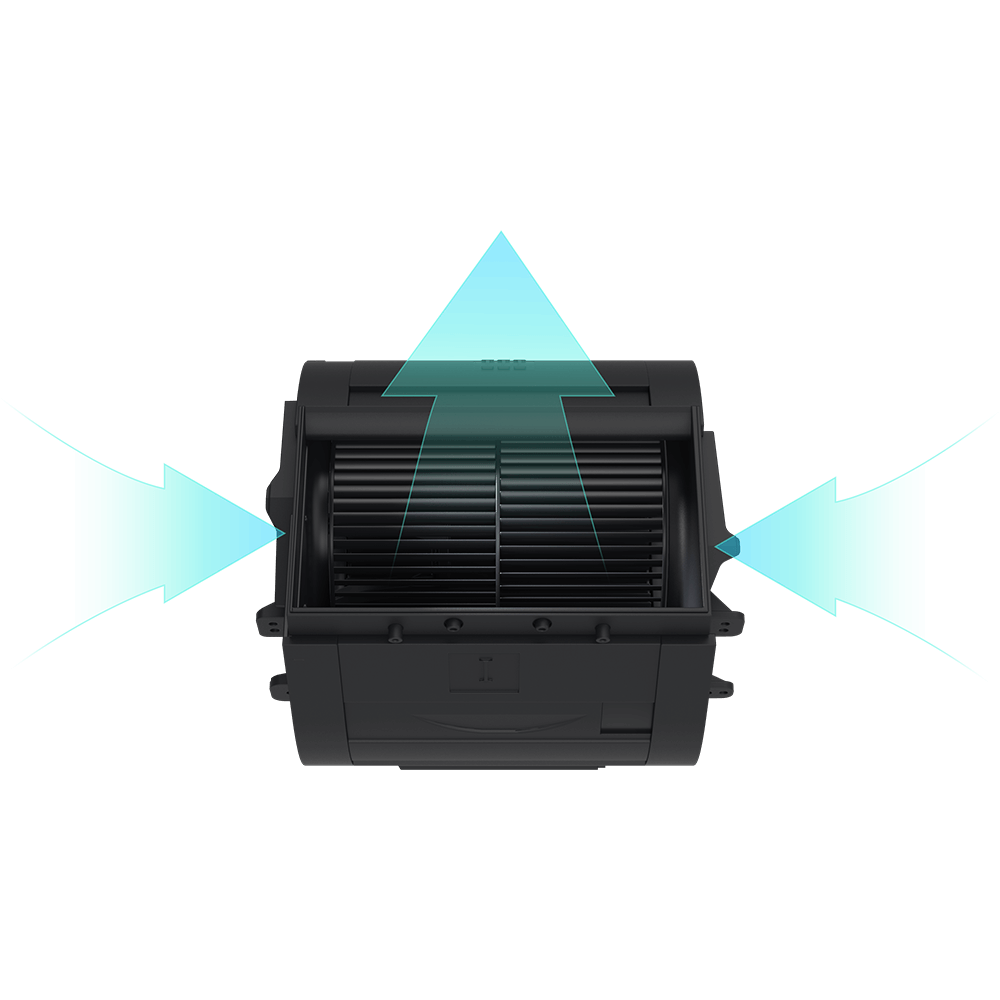
Lembro-me da altura em que me apercebi da importância do ar puro para os nossos entes queridos nos lares de idosos.
Os sistemas de purificação do ar HisoAir melhoram a qualidade do ar interior em lares de idosos, utilizando o H13 True HEPA e tecnologia avançada de várias fases. Isto retém eficazmente partículas, vírus e contaminantes transportados pelo ar, criando um ambiente mais seguro tanto para os residentes idosos como para o pessoal.
Tudo começou com a estadia da minha avó num lar para idosos. O ar parecia pesado, e eu preocupava-me frequentemente com a sua saúde num ambiente assim. Descobrir como os sistemas HisoAir podem transformar estes espaços foi um ponto de viragem. Com a sua tecnologia avançada, não só capturam as partículas nocivas, como também garantem a tranquilidade de famílias como a nossa. Vamos ver como é que estes sistemas fazem a diferença.
O HisoAir utiliza a filtragem H13 True HEPA.Verdadeiro
Os sistemas HisoAir utilizam filtros H13 True HEPA para capturar as partículas.
O HisoAir é ineficaz contra os vírus.Falso
Os sistemas HisoAir foram concebidos para capturar os vírus de forma eficaz.
O que torna a tecnologia HisoAir única?
Imagine entrar numa sala e sentir instantaneamente o ar fresco a abraçá-lo. O HisoAir torna isto uma realidade com a sua tecnologia inteligente.
A tecnologia HisoAir é um divisor de águas com o seu sistema de filtragem de várias fases, sensores de qualidade do ar em tempo real e um funcionamento silencioso, tornando-o eficaz e confortável para a utilização diária.

Sistema de filtragem avançado
Sabe aquela sensação quando se apercebe que o seu filtro velho e poeirento pode não ser suficiente? É aí que entra o HisoAir com a sua filtragem avançada de várias fases. Lembro-me da primeira vez que tomei conhecimento do H13 Verdadeiro HEPA filtragem1-foi como descobrir que há um super-herói no seu purificador de ar. Este sistema capta 99,95% de partículas minúsculas, tão minúsculas como 0,1 microns, e é como ter um escudo microscópico contra vírus, bactérias e alergénios.
| Caraterística | Descrição |
|---|---|
| HEPA Filtragem | Captura partículas e agentes patogénicos de forma eficaz |
| Carvão ativado | Elimina os odores e COVs |
Com esta combinação, pode respirar tranquilamente sabendo que o seu ar não é apenas limpo, mas também fresco.
Integração de tecnologia inteligente
Alguma vez desejou que o seu purificador de ar pudesse ler o ambiente e ajustar-se sozinho? Os sensores inteligentes da HisoAir fazem exatamente isso. Estes sensores monitorizam continuamente a qualidade do ar interior (QAI) e ajustar os níveis de filtragem sem ter de levantar um dedo. É como ter um pequeno assistente de qualidade do ar no seu canto, oferecendo informações em tempo real e ajustes automáticos que mantêm o seu espaço tão puro quanto possível.
- Monitorização em tempo real: Fornece informações sobre as flutuações da qualidade do ar.
- Ajustes automáticos: Adapta-se rapidamente às mudanças ambientais.
As instalações podem aceder a dados em tempo real através de painéis de controlo, aumentando a transparência e tomada de decisões com base em dados2.
Funcionamento ultra-silencioso
E vamos falar de ruído. Eu costumava pensar que todos os purificadores de ar eram barulhentos até que experimentei a tecnologia Decibel Cancellation™ da HisoAir. É perfeita para ambientes onde a paz é crucial, como lares de idosos ou escritórios onde a concentração é fundamental.

Benefícios em ambientes específicos
Lares de idosos
- Purificação localizada: As unidades podem ser colocadas nas áreas comuns e nos quartos dos residentes, oferecendo uma limpeza do ar personalizada sem necessidade de renovar os sistemas AVAC existentes.
Escritórios
- Melhoria da produtividade: Melhorado QAI conduz a uma melhor concentração e a menos dias de doença entre os trabalhadores.
A beleza do HisoAir é a forma como se adapta a diferentes ambientes, contribuindo para espaços de vida e de trabalho mais saudáveis. Saiba mais sobre estratégias de purificação localizadas3.
O filtro H13 HEPA da HisoAir capta 99,95% de partículas.Verdadeiro
A filtragem H13 True HEPA do HisoAir remove 99,95% de partículas.
As unidades HisoAir não dispõem de monitorização da qualidade do ar em tempo real.Falso
As unidades HisoAir possuem sensores para monitorização contínua da qualidade do ar em tempo real.
Como é que os purificadores de ar apoiam o controlo de infecções nos lares de idosos?
Imagine entrar num lar de idosos e respirar ar puro e fresco, sabendo que está a proteger o bem-estar dos seus entes queridos.
Os purificadores de ar reforçam o controlo de infecções nos lares de idosos, filtrando os agentes patogénicos transportados pelo ar, minimizando a propagação de vírus e melhorando a qualidade do ar, protegendo assim os residentes idosos vulneráveis de infecções respiratórias.

Importância da qualidade do ar interior nos lares de idosos
Sempre que visito a minha avó no seu lar de idosos, apercebo-me perfeitamente do ambiente em que ela vive. A qualidade do ar não tem apenas a ver com conforto; tem a ver com segurança. Os residentes idosos têm frequentemente o sistema imunitário comprometido, o que os torna mais susceptíveis a doenças transmitidas pelo ar, como COVID-194. Pobres QAI podem piorar as condições respiratórias e ajudar os agentes patogénicos a desenvolverem-se. Com a integração de purificadores de ar, podemos reduzir significativamente estes riscos para a saúde.
Como funcionam os purificadores de ar
Pense nos purificadores de ar como guardiões vigilantes do ar que respiramos. Eles empregam HEPA para apanhar partículas tão minúsculas como 0,3 microns - sim, isso inclui vírus, bactérias e alergénios. Alguns modelos avançados até fazem equipa com HEPA com carvão ativado para combater os odores e os compostos orgânicos voláteis (COVs).
| Caraterísticas | Benefícios |
|---|---|
| HEPA Filtragem | Captura 99,97% de partículas em suspensão no ar |
| Camada de carbono | Reduz os odores e COVs |
| Funcionamento silencioso | Assegura um ambiente tranquilo |
Colocação e eficiência
A colocação destes purificadores estrategicamente em espaços partilhados, quartos de residentes e corredores garante a cobertura de todas as bases. Ao contrário dos sistemas HVAC normais, estas unidades são autónomas, oferecendo uma purificação concentrada e uma melhor circulação do ar.
Monitorização em tempo real
Os purificadores de ar actuais são máquinas bastante inteligentes - vêm com sensores que ajustam a filtragem com base nos contaminantes detectados. Isto não garante apenas a melhor filtragem possível QAI mas também proporciona transparência à direção do lar e às famílias.
Estudo de caso: Sucesso da purificação do ar
Num caso convincente com HisoAir5Em relação aos vírus transportados pelo ar, foram observadas reduções significativas num lar de idosos. Os estabelecimentos referiram residentes mais saudáveis e menos infecções respiratórias.

Investir em sistemas de purificação do ar de alta qualidade é um investimento na saúde e segurança dos nossos estimados idosos e dos seus prestadores de cuidados, garantindo que estas instalações cumprem as diretrizes de saúde com distinção.
Os filtros HEPA captam 99,97% das partículas transportadas pelo ar.Verdadeiro
Os filtros HEPA são concebidos para capturar 99,97% de partículas tão pequenas como 0,3 microns.
Os purificadores de ar substituem os sistemas tradicionais de AVAC nos lares de idosos.Falso
Os purificadores de ar complementam os sistemas AVAC, proporcionando uma purificação localizada do ar, não os substituindo.

A melhoria da qualidade do ar pode melhorar a saúde geral dos residentes?
Respirar ar puro é mais do que um luxo - é uma tábua de salvação para uma boa saúde. Enquanto as cidades se esforçam por limpar os seus céus, vale a pena perguntar como é que estes esforços nos beneficiam verdadeiramente.
A melhoria da qualidade do ar pode melhorar significativamente a saúde, reduzindo a exposição a poluentes nocivos, diminuindo assim os problemas respiratórios e cardiovasculares. Um ar mais limpo contribui diretamente para o bem-estar geral, nomeadamente atenuando doenças como a asma.

O impacto da qualidade do ar na saúde
Lembro-me de quando me mudei para a cidade; o ar parecia denso, quase como se me estivesse a pesar. Só quando comecei a ter sintomas ligeiros de asma é que me apercebi de como a qualidade do ar podia afetar a minha saúde. Esta experiência não é única - muitas pessoas que vivem em zonas urbanas enfrentam desafios semelhantes devido à má qualidade do ar, que muitas vezes contém poluentes como PM2.5dióxido de azoto e compostos orgânicos voláteis (COVs). Estes poluentes podem provocar graves problemas respiratórios6 como a asma, a bronquite e até o cancro do pulmão.
A Organização Mundial de Saúde (OMS) realizou estudos que demonstram que a melhoria da qualidade do ar pode reduzir significativamente as doenças respiratórias crónicas. É reconfortante saber que quando respiramos ar mais limpo, estamos também a reduzir o risco de problemas cardiovasculares. Não se trata apenas de evitar doenças; trata-se de melhorar a nossa saúde geral qualidade de vida7.
Qualidade do ar interior e seus efeitos
Enquanto crescia, nunca me preocupei muito com o ar dentro de casa. Foi só quando visitei a minha avó num lar de idosos, onde a ventilação era deficiente, que compreendi a importância da qualidade do ar interior (QAI). Muitos edifícios, especialmente os mais antigos, têm uma ventilação inadequada, o que leva a uma acumulação de poluentes no interior. Os sistemas avançados de purificação do ar podem fazer toda a diferença, melhorando drasticamente QAI e reduzir a exposição a alergénios e agentes patogénicos.
Exemplo de tabela: Poluentes comuns de interiores e suas fontes
| Poluente | Fonte |
|---|---|
| Ácaros do pó | Tapetes, roupa de cama |
| Esporos de bolor | Paredes húmidas, Casas de banho |
| COVs | Tintas, produtos de limpeza |
| Fumo de tabaco | Cigarros |
Tecnologias que melhoram a qualidade do ar
A tecnologia sempre me fascinou, especialmente quando traz benefícios tangíveis, como um ar mais limpo. Tecnologias inovadoras como HEPA e os filtros de carvão ativado desempenham um papel fundamental na melhoria da qualidade do ar. Estes sistemas capturam partículas nocivas, assegurando uma circulação de ar mais limpa em espaços fechados.
Os purificadores de ar inteligentes, com capacidades de monitorização em tempo real, ajustam-se dinamicamente aos níveis de poluição actuais, apoiando a saúde e alinhando-se com as normas globais objectivos de sustentabilidade8 promovendo soluções energeticamente eficientes.
Benefícios societais mais vastos
Um ar mais limpo beneficia toda a gente - não apenas os indivíduos. Residentes mais saudáveis significam custos de saúde reduzidos e maior produtividade. As escolas com melhor qualidade do ar registam menos faltas dos alunos devido a doenças respiratórias.
Cidades como Copenhaga e Tóquio conseguiram reduzir a poluição através de regulamentos ambientais rigorosos, dando um exemplo a seguir.
Em conclusão, a melhoria da qualidade do ar é um esforço multifacetado que exige a cooperação entre vários sectores. Envolve tudo, desde iniciativas individuais em casa até quadros regulamentares mais alargados. Juntos podemos criar ambientes onde todos respiramos um pouco melhor.
A melhoria da qualidade do ar reduz a incidência de doenças respiratórias.Verdadeiro
Estudos da OMS mostram que um ar mais limpo conduz a menos doenças respiratórias crónicas.
Os filtros HEPA são ineficazes para melhorar a qualidade do ar interior.Falso
Os filtros HEPA capturam as partículas nocivas, melhorando significativamente a qualidade do ar interior.
Quais são os benefícios em termos de custos da utilização do HisoAir em instalações de cuidados a idosos?
Imagine-se a entrar numa sala e sentir o ar tão fresco que quase o consegue saborear.
A utilização do HisoAir em instalações de cuidados a idosos oferece benefícios em termos de custos, reduzindo as despesas de saúde, melhorando a produtividade do pessoal e diminuindo o consumo de energia. A sua filtragem avançada garante ambientes mais saudáveis, levando a menos custos relacionados com doenças e a um maior bem-estar dos residentes.

Resultados de saúde melhorados e poupanças de custos
Lembro-me de visitar a minha avó no seu centro de saúde e de cada fungada ou tosse entre os residentes me deixar ansiosa. O ar parecia pesado, como se estivesse saturado de preocupações com os riscos para a saúde. A integração dos sistemas HisoAir pode fazer toda a diferença, reduzindo custos dos cuidados de saúde9. Estes sistemas melhoram a qualidade do ar interior, o que pode minimizar significativamente a propagação de doenças transmitidas pelo ar. Menos doenças significam menos visitas ao hospital, o que é um alívio para todos os envolvidos. Um ar mais limpo pode reduzir os problemas respiratórios dos residentes, traduzindo-se em menos medicamentos e consultas médicas.
Aumento da produtividade do pessoal
Pense naqueles dias em que o ar parece denso, dificultando a concentração ou mesmo a respiração. Uma melhor qualidade do ar com o HisoAir beneficia o pessoal, melhorando o seu ambiente de trabalho. Com a redução da exposição a poluentes e alergénios, o pessoal tem menos dias de baixa. Vi em primeira mão como esta melhoria aumenta a produtividade e reduz custos de rotação do pessoal10. Um pessoal satisfeito presta melhores cuidados, o que conduz a melhores resultados para todos os envolvidos.
Eficiência energética e redução de custos operacionais
Os sistemas HisoAir são como aquele amigo que é um mestre na organização - tudo funciona sem problemas e sem esforço extra. Foram concebidos tendo em conta a eficiência energética e integram-se perfeitamente nas infra-estruturas existentes, sem necessidade de grandes adaptações. Isto significa evitar custos de instalação elevados. As instalações poupam nas despesas de energia, uma vez que as unidades HisoAir optimizam a circulação do ar de forma eficiente.
| Caraterística | Benefício |
|---|---|
| H13 Verdadeiro HEPA Filtragem | Reduz os custos médicos ao filtrar os agentes patogénicos |
| Sensores inteligentes | Reduz as facturas de energia através da otimização da purificação do ar |
| Funcionamento silencioso | Aumenta a concentração e a produtividade do pessoal |
Escalabilidade e benefícios de investimento a longo prazo
A conceção modular do HisoAir permite às instalações dimensionar os seus sistemas de acordo com as necessidades. Uma vez trabalhei com uma equipa que teve de ajustar os planos rapidamente devido a mudanças imprevistas, e ter soluções adaptáveis como esta é inestimável. Esta adaptabilidade torna-o um investimento a longo prazo, proporcionando melhorias consistentes na qualidade do ar ao longo do tempo. As instalações podem melhorar gradualmente a sua ambientes interiores11 sem custos iniciais muito elevados.
A implementação do HisoAir não só protege os residentes, como também se alinha com os objectivos financeiros, garantindo ambientes saudáveis que reduzem as despesas operacionais gerais. Estes sistemas apoiam a conformidade com os regulamentos de saúde, oferecendo paz de espírito às partes interessadas e às famílias. Para obter exemplos mais pormenorizados de poupanças de custos e aplicações práticas, é possível explorar mais investigação através das ligações relevantes.
O HisoAir reduz as visitas ao hospital ao melhorar a qualidade do ar.Verdadeiro
A melhoria da qualidade do ar minimiza as doenças transmitidas pelo ar, reduzindo as visitas ao hospital.
Os sistemas HisoAir requerem grandes adaptações nas instalações.Falso
O HisoAir integra-se sem problemas, sem necessidade de grandes adaptações.
Conclusão
Os sistemas de purificação do ar HisoAir melhoram a qualidade do ar interior nos lares de idosos, utilizando HEPA filtragem, reduzindo os agentes patogénicos transportados pelo ar e criando ambientes mais saudáveis para os residentes e o pessoal.
-
Saiba mais sobre a capacidade do sistema de filtragem H13 True HEPA para captar eficazmente partículas extremamente pequenas. ↩
-
Compreender como os sensores inteligentes melhoram a qualidade do ar, fornecendo dados em tempo real e ajustes automáticos. ↩
-
Descubra como a purificação localizada pode melhorar a qualidade do ar em áreas específicas dos lares de idosos. ↩
-
Compreender o impacto da COVID-19 nos lares de idosos realça a necessidade de purificadores de ar para mitigar os riscos. ↩
-
Explore um estudo de caso do mundo real que mostra a eficácia dos purificadores HisoAir na redução de infecções. ↩
-
Explore a forma como os poluentes contribuem para doenças respiratórias como a asma, fornecendo informações sobre prevenção e gestão. ↩
-
Compreender a relação entre um ar mais limpo e a redução dos riscos cardiovasculares. ↩
-
Descubra tecnologias energeticamente eficientes que se alinham com os objectivos globais de sustentabilidade. ↩
-
Explora estudos pormenorizados que mostram como uma melhor qualidade do ar reduz os custos dos cuidados de saúde, o que é crucial para os decisores. ↩
-
Fornece informações sobre como a melhoria da qualidade do ar aumenta a produtividade do pessoal, reduzindo a rotatividade e os custos associados. ↩
-
Discute a forma como os sistemas de purificação do ar escaláveis, como o HisoAir, beneficiam as instalações de cuidados a idosos a longo prazo. ↩







